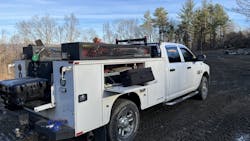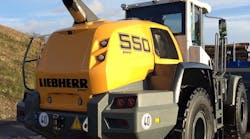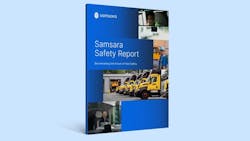Study Shows Big Safety Gains With A.I., Dual Cameras
A global analysis of 2,600 on-road fleets by the telematics firm Samsara has found A.I and dual dash cams with corresponding alerts lead to increased safety.
“For decades, fleet risk management relied on reactive response and one-on-one interventions,” says Johan Land, Samsara’s SVP of product and engineering, safety, and AI.
“Now it’s defined by real-time visibility, personalized coaching at scale, and measurable ROI. Fleets of all sizes are using data and AI to improve operations—and leaders are eager for insights that can help them better understand and improve driver safety,” Land says.
As reactive response can be too late to prevent and incident, fleets are increasingly relying on technology. The question is how far to go to see the maximum results.
How to choose camera technology
Fleets that have gone deeper into the technology—incorporating the company’s dual-facing AI dash cams—have seen a significant decrease in crash rates over time. Rates decreased 37% in six months and 73% in 30 months.
Breaking this down into three categories, harsh events, speeding, and mobile device usage, each category showed significant progress after six and 30 months.
Harsh events were down 48% in six months and 69% in 30 months, and speeding decreases by 4% at six months and improves more than 5 times for a 23% decrease in 30 months.
As for mobile device usage, one of the most dangerous distractions of driving, it decreases 84% over six months and a whopping 96% over 30 months.
The initial deployment of a new technology often spurs newfound awareness and action, Land says. Drivers may become aware of habits they were previously unaware of, leading to a quick and significant change.
The most egregious behaviors are often the easiest to identify and correct. Addressing these low-hanging fruits leads to quick, measurable improvements in the first few months, the study reports.
Adding training
The initial rollout of a new safety program is often accompanied byfocused training and communication, reinforcing the impor tance of the program and motivating drivers to adopt safer habits from the start.
After the initial period, the rate of improvement slows as the most obvious behavioral issues are addressed, and the focus shifts to a more gradual process of continuous reinforcement and fine tuning.
Larger fleets respond even more after time, Land says. He calls it "platform tenure."
After 30 months, fleets with more than 500 vehicles see, in aggregate, an 84% decrease in harsh events, a 23% decrease in speeding, and a 98% decrease in mobile usage.
Related Content
To understand how AI is accelerating safety outcomes, the firm compared the overall aggregated crash rate for fleets with 175+ vehicles to those that have implemented Samsara’s complete AI safety solution.
The difference is striking: fleets with 175+ vehicles using the full AI suite—including dual-facing AI Dash Cams,in-cab alerts, and driver coaching—achieve a 73% reduction in crash rates over 30 months, nearly 2 times compared to a 37% reduction among fleets with 175+ vehicles overall.
Together, these improvements emphasize the impact AI-driven visibility and real-time coaching have in delivering faster, deeper, and more sustained improvements in fleet safety performance.
When isolating safety improvements by camera type, Samsara says its customers who implement Dual-Facing Dash Cams see an aggregate reduction in crash rate 2 times greater than customers who implement Front-Facing Dash Cams alone.
Dual-Facing Dash Cams provide full visibility into both what ’s happening on the road and how the driver is behaving—making it possible to alert drivers to risky behaviors like drowsiness and mobile device usage. This creates a highly effective feedback loop that changes driver behavior.
Better CSA scores
Finally, camera and AI technology are producing better CSA scores.
CSA scores, or Compliance, Safety, and Accountability scores, are a key metric used by the Federal Motor Carrier Safety Administration (FMCSA) to assess the safety per formance of commercial motor carriers. These scores are essentially a percentile ranking that compares a carrier's safety record to that of its peers.
The lower the score, the better the company's safety performance. CSA scores are based on data from roadside inspections, crash reports, and investigations over a 24-month period.
This information is organized into seven Behavior Analysis and Safety Improvement Categories (BASICs): Unsafe Driving, Crash Indicator, Hours-of-Service (HOS) Compliance, Vehicle Maintenance, Controlled Substances/Alcohol, Hazardous Materials (HM) Compliance, and Driver Fitness.
Comparing fleet per formance prior to deploying Samsara, sand using the exact same profile for fleets with 175+ vehicles, the study analyzed how customers’ publicly available BASIC scores changed from the 30 months prior to the 30 months post-adoption. In aggregate, customers see:
- a 43% improvement in Unsafe Driving score
- 57% improvement in HOS Compliance score
- 35% improvement in Vehicle Maintenance score
- 83% improvement in Controlled Substances/Alcohol score
- and a 59% improvement in Driver Fitness score.
About the Author
Frank Raczon
Raczon’s writing career spans nearly 25 years, including magazine publishing and public relations work with some of the industry’s major equipment manufacturers. He has won numerous awards in his career, including nods from the Construction Writers Association, the Association of Equipment Manufacturers, and BtoB magazine. He is responsible for the magazine's Buying Files.




